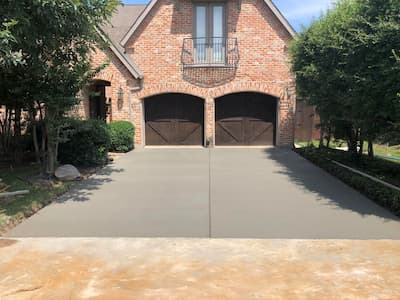Concrete became one of the most popular building materials because of how affordable and durable it is. Concrete surfaces can last for a long time when they’re applied correctly and cared for appropriately. Even so, it will eventually start to show signs of wear and tear, normally in the form of cracking. Luckily, there are several things you can do to prevent cracks in concrete.
Why Does Concrete Crack?
To prevent cracks in your concrete, start by learning about what may cause the problem in the first place. Damage normally occurs for one of eight different reasons.
-
Plastic Shrinkage
This happens when the mix loses water before becoming completely set, so the dry part becomes separated. This won’t happen if the concrete is applied appropriately and receives the correct care within the first few days while it cures.
-
Drying Shrinkage
Sometimes concrete shrinks while it’s drying because of the moisture that gets lost in this process. If the area wasn’t prepared correctly before the material was poured in, there will be stress points that lead to cracks.
-
Excess Water in Mix
Some people have the bad habit of adding too much water to concrete so it will be easier to install. Unfortunately, this also reduces the strength of concrete and leads to higher levels of shrinkage.
-
Missing Control Joints
Control joints help ensure that if the concrete does crack, it will do so in places where the cracks aren’t as catastrophic to the overall structure. When people pour a mix without using control joints, it’s much more likely that the concrete will become stressed in obvious places.
-
Settlement
The earth is always shifting and adjusting. This makes it extremely important to prepare the soil before pouring the concrete. If the mix isn’t poured over a stable base, it’s possible that the ground will settle in ways that leave the concrete unsupported. This can lead to cracks as well as larger damage like potholes.
-
Overload
There are different strengths of concrete, and it’s important to choose the right one for every job. If you choose a mix that’s too weak, it will get overloaded by stress and begin to wear out prematurely.
-
Chemical Damage
– Sometimes the strength of concrete can be reduced over time if it’s exposed to chemicals. This is especially common in garages, driveways, and parking lots since the material can be exposed to leaks from cars.
-
Corrosion and Erosion
– Corrosion is a natural process wherein materials undergo gradual chemical changes because of their interactions with the environment. Erosion is a physical change that happens when the material gets worn down. Either of these can eventually lead to cracks as the environment takes its toll.
How Bad Are Concrete Cracks?
We generally discuss concrete cracks by breaking them up into four different categories:
-
Structural Cracks
These are wide enough that you could fit your banking card inside, and they’re likely to run through the entire slab of concrete. They’ll have to be repaired or replaced.
-
Hairline Cracks
These are very small cracks that may not seem like a big deal at first. Over time, though, they’ll likely start to collect dirt, grow wider, or disrupt the surface of your concrete. If you don’t get them addressed right away, keep an eye on them over time so you’ll know when they get worse.
-
Settlement Cracks
These are some of the most obvious types of cracks, and they occur when part of the surface sinks. Settlement cracks are a sign that the surface of the ground wasn’t properly prepared before the concrete was laid. Otherwise, this could happen when there are large shifts in the earth underneath your concrete.
-
Shrinkage Cracks
These will happen almost immediately if they do occur. If you see cracks develop while your concrete is still curing, it’s likely that the joints weren’t placed properly.
How Bad Are Concrete Cracks?
Not all cracks are the same, and there’s no one size fits all way to address this problem. If the cracks bother you because they look bad, that’s enough of a reason to get your concrete
repaired or replaced. If cracks become wider than a banking card, run throughout the entire concrete, or go deep into the concrete, you should almost definitely consult a professional. These are signs of serious structural damage.
Another sign of bad cracks is that they get bigger over time. Once a crack starts increasing in size, it isn’t likely to stop all by itself. Cracks can also start to make the surface vulnerable to other environmental factors. For example, a crack may let moisture in and cause bigger problems, or it may collect dirt and become a sanitation issue.
How Can I Prevent Concrete Cracks?
The best way to prevent concrete cracks is to hire a professional who will apply the surface correctly in the first place. The best concrete companies in Texas will do four things to prevent cracks in concrete:
- Start with a solid subgrade and make sure everything is compacted to reduce settling.
Use the appropriate concrete mix for the job so it can stand up to environmental stress and other factors. Avoid adding too much water.
- Install joints throughout the concrete. It’s important to place these joints in the right places while also paying attention to the size and type of control joints.
- Take enough time to let the concrete cure completely, and complete the process correctly.
Concrete Repair and Replacement
Brick Experts provides quality
masonry and construction services for both residents and commercial property owners throughout Frisco, Southlake, Plano, Fort Worth, Flower Mound, and the rest of the surrounding areas. If you’re starting to notice cracks in your concrete, let us see how we can help you with your problem. We’ll respond as quickly as possible to restore the appearance and structural integrity of your surface. Contact us today for a free estimate on concrete care.










